Assign each signal in the ¹³C NMR spectra to the molecule shown.
(b) <IMAGE>

 Verified step by step guidance
Verified step by step guidance Verified video answer for a similar problem:
Verified video answer for a similar problem:



 4:m
4:mMaster 13C NMR General Features with a bite sized video explanation from Johnny
Start learning